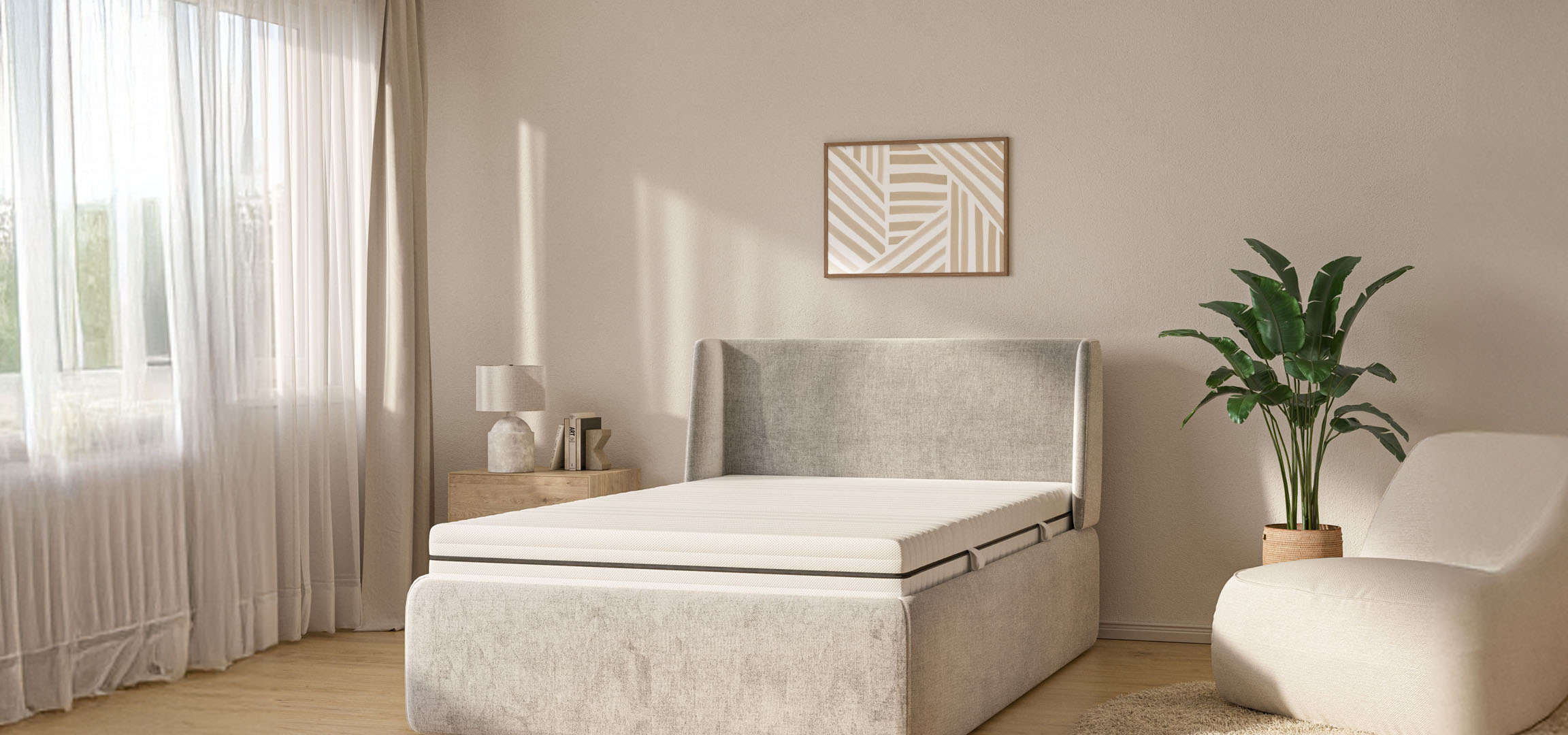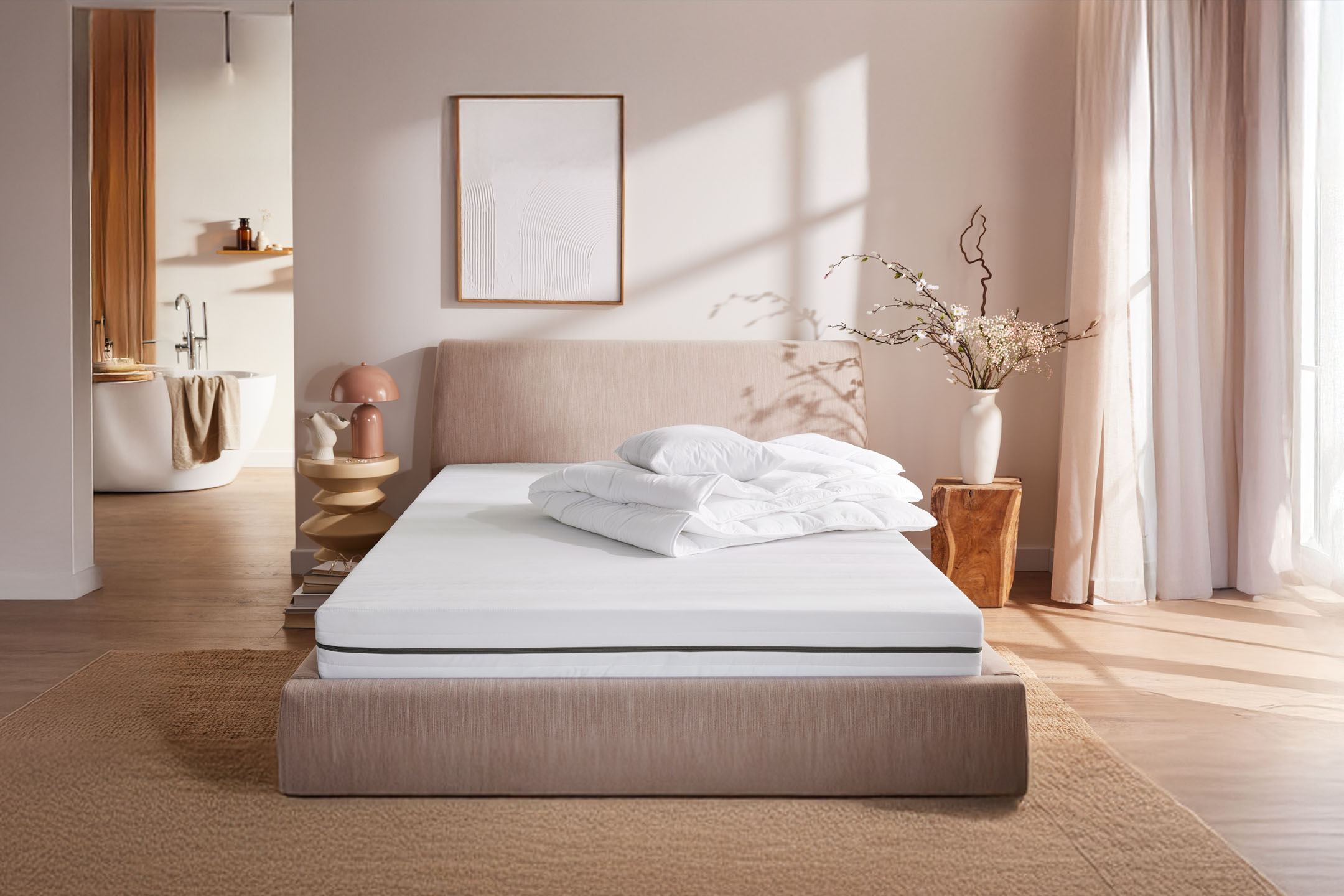Buying a mattress made easy: how to sleep better
To fall asleep quickly and wake up refreshed the next morning, a cozy bedroom is crucial. Plenty of blankets, soft bed linen and good pillows are required. But the basis for a restful night is a high-quality slatted frame with a good, quality mattress.
Find your mattress size
To find the correct mattress for your bed frame, you will need to measure the frame and purchase the correct mattress size. From the compact 90 x 200 cm mattress for single sleepers to the luxurious 200 x 200 cm that offers much larger sleeping space.
Single mattresses
The standard size for single mattresses for single beds is 90x190cm; perfect for children, teenagers and adults.
Double Beds
Standard Double Beds: 140 x 200 cm mattress is a standard size for double beds.
Queen size beds: 160 x 200 cm mattress is required to fit a queen-size beds. The perfect size for those who appreciate the comfort of a larger bed but don't want to take up the whole bedroom.
King Size: 180 x 200 cm mattress is required to fit a king size bed. The perfect size for couples who value comfort and plenty of space.
Super King: 200 x 200 cm mattresse is required to fit a Super King size bed. The ultimate size for luxurious sleeping comfort or great for families who require extra space for bed sharing.
You can also buy mattress toppers or protectors , along with fitted sheets to fit your exact mattress size.
Choosing the right level of mattress firmness
How to choose the right mattress depends on what level of firmness you require and what type of sleeper you are. Choosing the optimal firmness level can be challenging because it determines how comfortable you are in the end. If you are prone to back pain, it is all the more important to choose the right degree of firmness when buying a mattress.
As a rule of thumb, the mattress firmness should be adapted to your body weight and height: the heavier you are, the harder the mattress should be.
Hardness | Weight | Target group | properties | Hints |
|---|---|---|---|---|
H1 | Up to 60kg | Adults with low body weight or children | extra-soft, gentle support, adapts well to the body contours | too soft for people with back pain |
H2 | 60 - 80 kg | Suitable for most sleep types and body weights | balanced mix of comfort and body support | too soft for people with back pain |
H3 | 80 - 110 kg | good for people with average to higher body weight | strong body support, keeps the spine in a straight line | often recommended for people with chronic back pain |
H4 | 110 - 150 kg | ideal mattress for heavy people | very hard and possible as an orthopedic mattress for people with special needs | is also suitable for couples if the lying surface is small (e.g. 140 x 200 cm) |
H5 | Over150 kg | designed for people who are overweight | see above | see above |
Lying zones on a mattress

The areas in a mattress that are designed differently so that they optimally support different areas of the body. Our shoulder and pelvic area is often softer, while the lumbar area is firmer. The lying zones support these areas accordingly and this in turn promotes an ergonomic lying position and can prevent back problems.
- 5-zone mattresses: Simple but effective. 5-zone mattresses offer good basic support and are often a little cheaper.
- 7-zone mattresses: The most common and suitable for most people. They adapt well to the body and are very comfortable.
- 9-zone mattresses: score with maximum adaptability. Particularly suitable for people with special orthopedic needs or pain.
Buy a mattress with confidence: choosing the perfect mattress type for you
Now that you've decided on the right level of firmness, it's time to consider the type of mattress. Whether it's a spring mattress or a foam mattress, each model has its own advantages that affect your sleeping comfort.
Type of mattress | Mattress description | Recommended for |
|---|---|---|
Spring mattresses |
|
|
Cold foam mattresses |
|
|
Latex mattresses |
|
|
Viscose foam mattresses |
|
|
Gel mattresses |
|
|
Pocket spring mattress |
|
|
Foam mattress |
|
|
Mattress with Bonell spring core |
|
|
Comfort foam mattress |
|
|
Gel foam mattress |
|
|
Memory foam mattress |
|
|
Hybrid mattress |
|
|
Mattresses for allergy sufferers
Fortunately, people with allergies now have a wide choice of mattresses that do not cause unpleasant reactions. If you have allergies, latex and foam mattresses are the best choice, as they are less sensitive to mites and mold. There are mattresses that are specially marked as "allergy-friendly" - you can choose them without hesitation.
A mattress that suits your sleep type
Whether you sleep on your side, back or stomach - here we show you how to choose the right level of firmness based on your sleep type when buying a mattress:
For people who sleep on their side
Such a mattress should fit well to the contours of the body to avoid pressure points on the shoulders and hips. A softer to moderately firm mattress, depending on body weight, is often the best choice here.
Recommended hardness level: H1 to H3
Suitable mattress types: memory foam mattresses, latex mattresses, 7-zone mattresses
For people who sleep on their backs
They need a mattress that supports the spine well and at the same time provides sufficient comfort. A medium to firm mattress is ideal in this case.
Recommended level of firmness: H2 to H4
Suitable mattress types: spring mattresses, latex mattresses, 9-zone mattresses
For people who sleep prone
Must be firm to very firm. People who sleep prone often have the problem that their spine is pressed in an unnatural position. A firm mattress provides the necessary support and keeps the spine in a neutral position.
Recommended level of firmness: H3 to H4
Suitable mattress types: spring mattresses, hybrid mattresses, 9-zone mattresses
Mixed sleep
If you toss and turn a lot in your sleep and adopt different postures, a medium firmness mattress is often the best choice. It offers a good balance of support and comfort for all sleeping positions.
Recommended firmness level: H2 to H3
Suitable mattress types: hybrid mattresses, 7-zone mattresses, latex mattresses.
Comfort meets practicality: mattress for various uses
Mattresses don't just go on beds. If you like to host family and friends for the evening, but there is no free bed available, you simply need a hospitality mattress. Make sure the guest mattress isn't too heavy so you can make it available to guests without too much trouble. If you regularly have overnight guests or even like to sleep on the floor yourself, then floor mattresses that offer a good balance between comfort and stability are suitable, e.g. foam mattresses, latex mattresses or memory foam mattresses. For long-term sleep on a floor mattress, good air circulation is vital for long-term sleep enjoyment - a cool foam mattress is just the thing for this.
How often should you change your mattress?
At some point, even the best mattress comes to the end of its life. But when is the right time to replace it? As a general rule, you should change your mattress every 7-10 years. Sooner, if it sags or has dents, if you wake up in the morning with head or back pain, or if your allergy symptoms have worsened.
How much does a good mattress cost?
A comfortable mattress doesn't have to cost a lot. Good entry-level models are available from as little as 100 to 200 euros. And at LIDL you can get really great deals: Many of our mattresses are on sale - don't miss out on them!




